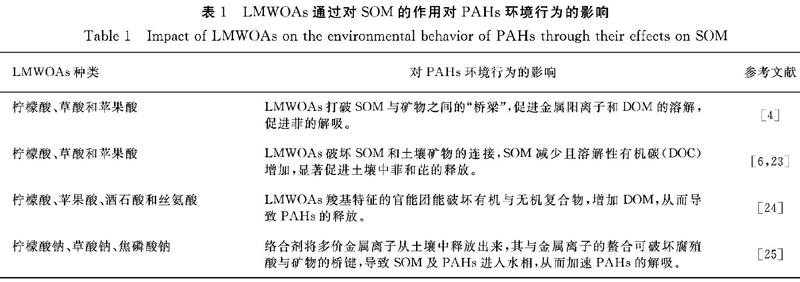小分子有机酸对土壤中多环芳烃环境行为影响的研究进展
2020-01-07袁月
袁月


摘 要:土壤中的多环芳烃(polycyclic aromatic hydrocarbons,PAHs)作为一类具有“三致”效应的疏水性有機污染物,能在土壤中长时间稳定的存在并且很难被降解。PAHs的环境行为取决于它们与土壤不同组分之间的相互作用,作为土壤中根系分泌物主要组分的小分子有机酸(low molecular weight organic acids,LMWOAs)能通过对土壤环境的影响进而影响PAHs的环境行为。综述了LMWOAs对土壤中PAHs吸附-解吸和“老化”等环境行为的影响,讨论了LMWOAs通过对土壤有机质、土壤结构及土壤微生物等的作用而影响PAHs的环境行为。通过综述该领域近年的研究成果,指出了现有研究中的不足,并展望了今后的研究趋势,有利于推动对PAHs污染土壤的有效治理。
关键词:小分子有机酸;多环芳烃;土壤有机质;土壤结构;土壤微生物
中图分类号:X53 文献标志码:A 文章编号:0253-2301(2020)10-0062-08
DOI: 10.13651/j.cnki.fjnykj.2020.10.011
Abstract: As a group of hydrophobic organic pollutants with ″three genicity″ effects, Polycyclic aromatic hydrocarbons (PAHs) in soil can exist steadily for a long time and are difficult to be degraded. The environmental behavior of PAHs depends on their interaction with different soil components. Low-molecular-weight organic acids (LMWOAs), as the main components of root exudate in soil, can affect the environmental behavior of PAHs by influencing the soil environment. The effects of low-molecular-weight organic acids (LMWOAs) on the environmental behaviors of PAHs in soil such as adsorption-desorption, and aging were reviewed. LMWOAs affecting the environmental behaviors of PAHs through their effects on soil organic matter, soil structure and soil microorganisms were discussed. By summarizing the research achievements in this field in recent years, the deficiencies of the existing research were pointed out and the research trend in the future was forecasted, which would be helpful to promote the effective treatment of PAHs contaminated soil.
Key words: Low-molecular-weight organic acids;Polycyclic aromatic hydrocarbons;Soil organic matter;Soil structure;Soil microorganism
多环芳烃(polycyclic aromatic hydrocarbons,PAHs)是由两个或两个以上的苯环稠合形成的一类疏水性有机化合物,其化学性质稳定且易吸附于固体颗粒,一些PAHs化合物在环境中具有持久性[1-2]。人类活动(如化石燃料的不完全燃烧、汽车尾气排放以及原油的泄漏等)是环境中PAHs的主要来源[3]。土壤是PAHs的一个主要陆地储存库,2014年4月17日我国环境保护部和国土资源部发布的《全国土壤污染状况调查公报》中指出,PAHs的点位超标率为1.4%。PAHs进入土壤后会发生一系列物理、化学和生物过程,包括吸附-解吸、微生物降解等[4-5]。土壤有机质、溶解性有机质、土壤组成与空间结构等多种环境因素都会对土壤中PAHs的环境行为产生影响[6-7]。土壤中PAHs的吸附解吸和“老化”等环境行为主要受土壤有机质(SOM)的含量和质量以及团聚体结构特征等因素的影响;而微生物活性则是影响土壤中PAHs去除的一个直接因素[8]。小分子有机酸(low-molecular-weight organic acids,LMWOAs)是一类具有一个或多个羧基的小分子有机物,作为土壤中可溶性有机物的最重要组成部分之一,能通过对土壤有机质、土壤结构以及土壤微生物等的作用而影响PAHs的土壤环境行为[9-12]。本文系统地综述了LMWOAs通过对土壤有机质的作用或对土壤结构的破坏而影响PAHs的吸附解吸;同时,总结了LMWOAs作为碳源、影响降解菌生长环境进而对土壤微生物产生的影响。阐述了LMWOAs对土壤中PAHs环境行为的影响及其作用机制等方面的研究进展,以期为更好地了解和利用LMWOAs对土壤中PAHs的修复提供参考。
1 LMWOAs对土壤有机质作用的影响
有机质是土壤的重要组成部分,SOM已被证明是土壤和沉积物中疏水性有机污染物的主要汇聚区[13]。SOM含量是影响污染物吸附形态和生物有效性的主要土壤性质[14-15]。SOM含量高的土壤具有更多的吸附位点,对PAHs的吸附量和吸附强度均较高,能够与PAHs紧密结合并限制其流动性,同时限制土壤中PAHs的降解[16-17]。另外,SOM的结构特征也会影响有机污染物的吸附行为。SOM的芳香组分易于与PAHs形成π-π键,天然有机质的脂肪族结构通过疏水性作用使污染物吸附在橡胶态有机碳区域[18-20]。同时,芳香性较高且极性较小的SOM成分具有较高的吸附能力,黏性“橡胶态”的SOM比刚性“玻璃态”的SOM具有更快的吸附速率[21]。
在自然土壤中,有机质和黏土矿物常通过金属阳离子结合在一起以有机无机复合体的形态存在[22]。而土壤中LMWOAs常与黏土矿物共存,LMWOAs具有羧基、羟基或者氨基等基团,与金属阳离子具有较强的螯合能力,能与土壤中的黏土矿物和有机组分等发生作用,进而会影响SOM上污染物的吸附-解吸等行为。表1列出了一些关于LMWOAs通过对SOM的作用进而对PAHs环境行为产生影响的研究结果。
部分研究认为,LMWOAs对土壤中PAHs吸附-解吸的影响,主要是通过其对SOM的作用[26]。LMWOAs与金属离子的螯合作用打破了有机质与矿物之间的“桥梁”,使SOM与矿物之间的离子桥键断开,促进了金属阳离子和溶解性有机质(DOM)的释放。DOM是由较小的有机分子通过疏水性作用或氫键作用形成的超分子聚合物[27-28]。它虽仅占SOM的很小部分,但能作为PAHs等有机污染物在土壤中迁移的载体,有利于土壤中污染物的迁移和转化[29-30]。因此,LMWOAs的作用促使土壤固相有机质减少,DOM增加。DOM增加的过程中,吸附在固相有机质上的PAHs向溶液相转移,使原本被锁定的PAHs得到释放,这可能是土壤中PAHs解吸量增多的重要原因。
LMWOAs对SOM的作用除了能够导致土壤有机矿质复合体中固相有机质释放、DOM增加以外,在这一过程中SOM的聚合程度可能也发生了变化。有研究表明,通过使用纤维素酶使固相土壤有机质转变为DOM的过程中,会降低SOM的刚性,使SOM结构变得松散[31]。研究认为,土壤腐殖质是来源于生物物质分解或降解的相对较小的分子通过自组装缔合而形成的超分子,这种超分子主要是通过弱的分子间作用力(疏水作用力:范德华力、ππ、CHπ;氢键)而非共价键作用形成的分子聚集体[32-33];腐殖质的超分子结构在一定的环境条件下又可以解聚成不同的小分子有机质[34-35]。有机质的还原和聚合程度越高,污染物的解吸滞后程度越大,解吸速率越慢,生物有效性也就越低[36-37]。LMWOAs的螯合能力是否使有机质结构变得松散,导致有机质聚合程度降低,进而促进了土壤中PAHs迁移或解吸。有关此方面的研究还没有准确的结论。
此外,SOM在不同的pH条件下会以不同的物理形态(卷曲或拉伸)存在,并对疏水性有机污染物表现出不同的吸附能力[38-39]。土壤pH是影响土壤和矿物表面电荷、调节土壤养分、影响有机污染物存在形式以及土壤微生物活性的重要因素[40-41]。较高的pH值会使得有机污染物和SOM在水相中的溶解度增加,从而促进SOM的脱附和有机污染物的解吸[42]。
LMWOAs添加会影响土壤pH。研究表明,LMWOAs对土壤中PAHs的解吸有促进作用,然而LMWOAs对PAHs解吸的促进作用并不是一直随着LMWOAs浓度的增加而增强。有研究发现,在一定浓度范围内,当LMWOAs浓度高于一定值时,LMWOAs对土壤中PAHs解吸的促进作用就会减弱[43]。究其原因可能是高浓度LMWOAs的添加导致了土壤pH值的变化,当LMWOAs的浓度超过一定数值可能会影响LMWOAs有机阴离子对PAHs解吸促进的作用能力[44]。具体的影响及机理有待进一步研究。
2 LMWOAs对土壤结构破坏的影响
土壤的组成和空间结构影响土壤颗粒与PAHs的相互作用[45],进而影响PAHs的吸附-解吸、老化等环境行为。在PAHs污染土壤中,随着老化时间的增加,PAHs会分散到SOM的刚性相中或缓慢扩散进入土壤微孔结构[46-47]。PAHs可以被锁定在这些微小孔隙中。吸附在土壤微孔结构内的PAHs,只有通过转运的方式才能被微生物接触进而被降解[48-49]。
LMWOAs通过其羟基、羧基与矿物中金属离子之间发生螯合作用,促进金属离子从矿物表面的释放,改变土壤微孔分布,进而影响吸附在其上的PAHs环境行为。Wang等[50]通过使用苹果酸,柠檬酸,琥珀酸和酒石酸这4种LMWOAs研究其对黑土、红土、木质素和腐殖质的微孔特性的影响。结果表明,柠檬酸和苹果酸的添加显著降低了土壤微孔的表面积和体积,但是这两种酸对于木质素微孔没有显著改变。因此,土壤微孔体积减小的主要原因并不是微孔被堵塞,而可能是由于LMWOAs增强了对矿物中金属离子的争夺,导致了土壤矿物颗粒的溶解。随着土壤微孔的破坏,矿物质颗粒的溶解,锁定在土壤孔隙中的PAHs被释放。PAHs的迁移率和流动性得到了提高,有机会被微生物接触进而被降解。
土壤团聚体空间结构特征(例如比表面积、孔隙度和粒径大小)影响氧气渗透率与PAHs的生物可接近性[51]。土壤团聚体对PAHs具有锁定作用。自然土壤中,土壤团聚体结构形成的过程会将有机质吸附的PAHs包裹其中,使其很难解吸或溶出。团聚体能够形成物理屏障反过来保护有机质,使微生物和酶很难接近底物,进而使PAHs的生物有效性降低。土壤团聚体不同粒径组分通过阳离子(如Ca2+、Mg2+、Fe2+、Al3+等)形成桥键而复合成粒径较大的组分[52]。LMWOAs能与金属阳离子发生螯合作用,破坏土壤团聚体结构,使得包裹在团聚体内部的PAHs被释放,PAHs的生物有效性得到提高。LMWOAs通过与土壤结构中无机离子的螯合作用导致了部分土壤结构的溶解,从而提高PAHs与微生物或酶的接触机会,提高PAHs生物有效性[52]。
然而,土壤中的阳离子不仅会在土壤有机质与矿物之间形成桥键,有机质分子间或分子内部也会通过金属阳离子桥键结合。研究表明,多价金属离子可以作为土壤有机质聚合的交联剂,通过与有机质不同支链上的羧基或酚羟基配位而增加有机质的刚性[25]。LMWOAs与土壤中阳离子的络合不仅破坏了有机质与矿物之间桥键,而且也可能破坏了有机质分子间或分子内部的阳离子桥键。仍需进一步研究LMWOAs是否通过影响土壤有机质的聚合程度、破坏有机质分子之间或有机质分子内部的阳离子桥键,使有机质结构变得松散进而促进了土壤中PAHs的解吸。
3 LMWOAs对土壤微生物的影响
一般认为,PAHs等有机污染物在被土壤吸附后,随着时间的增加,污染物与土壤结合得更紧密,导致其生物有效性下降,这一过程即为“老化”。土壤中有机污染物的生物有效性常被认为是控制污染物降解速率和污染土壤生物修复成功与否的重要因素[53]。随着老化时间的增加,PAHs生物有效性的下降,PAHs的可提取性也会显著降低[54],进而限制PAHs的原位生物降解、影响PAHs污染土壤的修复效率[55]。
在众多的PAHs污染修复方法中,微生物修复因其低成本、高效、污染少等优点成为研究热点。微生物降解已成为最主要的多环芳烃污染土壤的修复技术。微生物、细菌、真菌和藻类具有自然降解潜力,能应用于有机污染物的生物修复,使PAHs等有机污染物转化为毒性较小的化合物或易于被环境吸收的水和二氧化碳[56]。土壤微生物对污染物的降解是成本效益最低的污染物修复过程[57]。研究表明,LMWOAs通过改变土壤环境进而影响土壤微生物对PAHs的降解能力,并且LMWOAs对土壤中PAHs生物有效性的提高有促进作用。表2列出了一些关于LMWOAs影响土壤中PAHs生物有效性及降解能力的相关研究。
已知碳源、氮源以及无机盐是微生物生长所必需的营养物质,给微生物提供充足的营养物质可以提高微生物的修复性能。外加碳源能够在一定程度上缩短降解菌对PAHs进入快速降解的时间[63]。研究认为,LMWOAs能作为微生物可利用的碳源,提高微生物对PAHs的降解能力。王蛟龙等[12]通过测定添加LMWOAs后污染土壤中菲含量及土壤细菌群落种类和数量的变化,结果发现添加LMWOAs减少了细菌OTU数及细菌菌群多样性,但增加了PAHs降解菌的丰度。Sivaram等[10]的研究结果也表明,当芘是唯一的碳源时,试验选用的所有菌株都不能将芘完全降解,在添加柠檬酸等LMWOAs后,细菌以LMWOAs作为碳源而促进了生长,从而提高了其对PAHs的降解能力。LMWOAs通过作为土壤微生物可利用的碳源,激发了土壤微生物活性,从而促进了PAHs的降解。
另外,土壤养分、土壤酶活性会影响土壤环境中微生物对PAHs的降解,影响PAHs的生物有效性。一般情况下, 微生物对PAHs的降解都需要氧气的参与,产生加氧酶,然后再在加氧酶的作用下使苯环分解[64]。土壤微生物数量、土壤酶活性是影响PAHs降解效率的重要因素[65-66]。土壤中微生物数量与酶活性呈显著正相关[67]。土壤环境中的养分含量是降解菌存活的重要基础,对微生物活性有很大影响。
LMOWAs能与土壤中Al3+、Ca2+等金属阳离子的发生螯合作用[61],促使氮、磷元素的释放,为土壤中降解菌的生长提供养分[68]。Rostami等[60]的研究结果显示,水杨酸和菌根真菌的同时施用增加了土壤中的细菌数量、脱氢酶活性,进而增强了高羊茅修复PAHs污染土壤的能力,使得土壤中氟、蒽的去除率显著提高。在土壤环境中,土壤酶活性的增强能够激活土壤中的氮、磷等养分元素,进而促进微生物的生长。另有研究表明,施用LMWOAs对土壤中金属离子的争夺作用会使矿物增溶,能显著提高土壤中有效磷的含量,土壤酶的活性也显著增强,土壤中养分含量的增加促进特定微生物的增长,进而促进了其对土壤中PAHs的降解[58]。
然而,在关于LMWOAs对土壤中PAHs生物有效性影响的研究中,部分研究通过使用有机溶剂等的提取来预测LMWOAs对土壤中PAHs生物有效性的影响,或者根据对土壤中PAHs解吸量的多少来判断其生物有效性。而有机溶剂提取本身会对PAHs的生物有效性产生影响。研究表明,向土壤中加入有机溶剂有利于PAHs类污染物从土壤基质上的解吸,能够提高PAHs的生物有效性,增强PAHs的生物降解[69]。有机溶剂能够作为萃取剂对污染土壤中的PAHs表现出较好的去除效果。所以在进行研究时不能忽视有机溶剂本身起到的促进作用。
4 结语与展望
目前关于LMWOAs对土壤中PAHs环境行为影响的研究已取得了较好的成果,部分研究认为LMWOAs通过对土壤有机质的作用或对土壤结构的破坏而促进土壤中PAHs的解吸;并指出LMWOAs影响PAHs生物有效性的机制是通过作为微生物生长所需的碳源、影响其生长环境等。然而,相关研究多选用能与金属离子发生螯合作用的一类LMWOAs,认为其通过破坏有机质与矿物之间桥键,使有机质溶解或破坏土壤结构,进而影响PAHs的环境行为。未考虑LMWOAs是否使SOM解聚或减弱SOM的聚合程度而对PAHs环境行为产生影响。关于LMWOAs对PAHs生物有效性的研究,更多地考虑LMWOAs对微生物的作用而影响PAHs的生物有效性,而較少的研究其对土壤、矿物及有机质结构的破坏促进了PAHs解吸,进而提高了PAHs的生物可降解性。
鉴于土壤环境的复杂性和土壤中PAHs污染的多样性,关于LMWOAs对土壤中PAHs环境行为影响的研究,仍需在很多方面进行更加深入地探索。(1)有必要研究LMWOAs对土壤有机质聚合程度的改变是否对土壤中PAHs的解吸造成了影响。判断LMWOAs是否破坏了有机质分子间或分子内部的阳离子桥键,从而对PAHs的解吸起到了促进作用。(2)LMWOAs促进土壤中PAHs微生物降解的真正机制是什么?LMWOAs是否是通过对土壤、矿物及有机质结构的破坏促进PAHs解吸,进而提高了PAHs的生物可降解性,而不仅是其作为微生物可利用碳源的作用。目前关于上述方面的研究仍很不清楚,有待于深入探索。研究结果可以为PAHs的微生物修复提供新的思路,为污染土壤的修复治理提供理论依据。这些都将是值得进一步研究的课题。
参考文献:
[1]MENZIE C,POTOCKI B,SANTODONATO J.Exposure to carcinogenic PAHs in the environment[J].Environmental Science & Technology,1992,26:1278-1284.
[2]BEZZA F,CHIRWA E.Biosurfactant-enhanced bioremediation of aged polycyclic aromatic hydrocarbons(PAHs)in creosote contaminated soil[J].Chemosphere,2016,144:635-644.
[3]SHARMA D,JAIN S.Impact of intervention of biomass cook-stove technologies and kitchen characteristics on indoor air quality and human exposure in rural settings of India[J].Environ Int,2019,123:240-255.
[4]MACLEOD C J A,SEMPLE K T.Sequential extraction of low concentrations of pyrene and formation of non-extractable residues in sterile and non-sterile soils[J].Soil Biology & Biochemistry,2003,35:1443-1450.
[5]王春霞.環境化学学科前沿与展望[M].北京:科学出版社,2011.
[6]WEISSENFELS W,KLEWER H,LANGHOFF J.Adsorption of polycyclic aromatic hydrocarbons(PAHs)by soil particles:Influence on biodegradability and biotoxicity[J].Applied Microbiology & Biotechnology,1992,36:689-696.
[7]邢维芹,骆永明,李立平.影响土壤中PAHs降解的环境因素及促进降解的措施[J].土壤通报,2007,38(1):173-178.
[8]ALEXANDER M.Aging,Bioavailability,and overestimation of risk from environmental pollutants[J].Environmental Science & Technology,2000,34:4259-4265.
[9]GAO Y,REN L,LING W,et al.Desorption of phenanthrene and pyrene in soils by root exudates[J].Bioresource Technology,2010,101:1159-1165.
[10]SIVARAM A,LOGESHWARAN P,LOCKINGTON R,et al.Low molecular weight organic acids enhance the high molecular weight polycyclic aromatic hydrocarbons degradation by bacteria[J].Chemosphere,2019,222:132-140.
[11]LING W,SUN R,GAO X,et al.Low-molecular-weight organic acids enhance desorption of polycyclic aromatic hydrocarbons from soil[J].European Journal of Soil Science,2015,66:339-347.
[12]王蛟龙,谌小勇,闫文德.低分子有机酸对土壤中菲降解及细菌群落结构的影响[J].生态学报,2019(19):7179-7188.
[13]MEANS J,WOOD S,HASSETT J,et al.Sorption of polynuclear aromatic hydrocarbons by sediments and soils[J].Environmental Science & Technology,1980,14:1524-1528.
[14]CELIS R,JONGE H D,JONGE L W D,et al.The role of mineral and organic components in phenanthrene and dibenzofuran sorption by soil[J].European Journal of Soil Science,2010,57:308-319.
[15]YANG Y,ZHANG N,XUE M,et al.Efects of soilorganic matter on the development of the microbial polycyclicaromatic hydrocarbons(PAHs)degradation potentials[J].Environmental Pollutants,2011,159:591-595.
[16]NAM K,CHUNG N,ALEXANDER M.Relationship between organic matter content of soil and the sequestration of phenanthrene[J].Environmental Science & Technology,1998,32:3785-3788.
[17]WATANABE N,SCHWARTZ E,SCOW K,et al.Relating desorption and biodegradation of phenanthrene to SOM structure characterized by quantitative pyrolysis GCMS[J].Environmental Science & Technology,2005,39:6170-6181.
[18]SALLOUM M J,CHEFETZ B,HATCHER P G.Phenanthrene sorption by aliphatic-rich natural organic matter[J].Environmental Science & Technology,2002,36:1953-1958.
[19]MAO J D,HUNDAL L S,THOMPSON M L,et al.Correlation of poly(methylene)-rich amorphous aliphatic domains in humic substances with sorption of a nonpolar organic contaminant,phenanthrene[J].Environmental Science & Technology, 2002,36:929-936.
[20]GUNASEKARA A S,XING B.Sorption and desorption of naphthalene by soil organic matter[J].Journal of Environmental Quality,2003,32:240-246.
[21]XING B,PIGNATELLO J.Dual-mode sorption of low-polarity compounds in glassy poly(vinyl chloride)and soil organic matter[J].Environmental Science & Technology,1997,31:792-799.
[22]SAISON C,PERRIN-GANIER C,AMELLAL S,et al.Effect of metals on the adsorption and extractability of 14C-phenanthrene in soils[J].Chemosphere,2004,55:477-485.
[23]JIA H,CHEN H,NULAJI G,et al.Effect of low-molecular-weight organic acids on photo-degradation of phenanthrene catalyzed by Fe (III)-smectite under visible light[J].Chemosphere,2015,138:266-271.
[24]WANG H.Effect of artificial root exudates on the sorption and desorption of PAHs in meadow brown soils[J].AIP Conference Proceedings,2017,1890:1-4.
[25]YANG Y,RATT D,SMETS B F,et al.Mobilization of soil organic matter by complexing agents and implications for polycyclic aromatic hydrocarbon desorption[J].Chemosphere,2001,43:1013-1021.
[26]LING W,SUN R,GAO X,et al.Low molecular weight organic acids enhance desorption of polycyclic aromatic hydrocarbons from soil[J].European Journal of Soil Science,2015,66:339-347.
[27]SUTTON R,SPOSITO G.Molecular structure in soil humic substances:the new view[J].Environmental Science & Technology,2005,39:9009-9015.
[28]徐玉芬,吳平霄,党志.水溶性有机质对土壤中污染物环境行为影响的研究进展[J].矿物岩石地球化学通报,2007(3):101-106.
[29]ZHANG J,FAN S.Influence of PAH speciation in soils on vegetative uptake of PAHs using successive extraction[J].Journal of Hazardous Materials,2016,320:114-122.
[30]黄赛花,吴启堂,侯梅芳,等.水溶性有机质对土壤吸附芘的影响[J].生态环境学报,2017(4):693-699.
[31]WICKE D,REEMTSMA T.Mobilization of hydrophobic contaminants from soils by enzymatic depolymerization of soil organic matter[J].Chemosphere,2010,78:996-1003.
[32]PICCOLO A.The supramolecular structure of humic substances:A novel understanding of humus chemistry and implications in soil science[J].Advances in Agronomy,2002,75:57-134.
[33]SUTTON R,SPOSITO G.Molecular structure in soil humic substances: the new view[J].Environmental Science & Technology,2005,39:9009-9015.
[34]MEJKALOV D,PICCOLO A.Aggregation and disaggregation of humic supramolecular assemblies by NMR diffusion ordered spectroscopy(DOSY-NMR)[J].Environmental Science & Technology,2007,42:699-706.
[35]NI J,PIGNATELLO J.Charge-assisted hydrogen bonding as a cohesive force in soil organic matter: water solubility enhancement by addition of simple carboxylic acids[J].Environmental Science:Processes & Impacts,2018,20:1225-1233.
[36]LUEKING A D,HUANG W,SODERSTROM-SCHWARZ S,et al.Relationship of Soil Organic Matter Characteristics to Organic Contaminant Sequestration and Bioavailability[J].Journal of Environmental Quality,2000,29:317-323.
[37]倪進治,骆永明,魏然.土壤有机和无机组分对多环芳烃环境行为影响的研究进展[J].土壤,2006(5):559-564.
[38]MURPHY E,ZACHARA J,SMITH S,et al.Interaction of hydrophobic organic compounds with mineral-bound humic substances[J].Environmental Science & Technology,1994,28:1291-1299.
[39]FENG X,SIMPSON A,SIMPSON M. Investigating the role of mineral-bound humic acid in phenanthrene sorption[J].Environmental Science & Technology,2006,40:3260-3266.
[40]WANG A,LI S,TENG Y,et al.Adsorption and desorption characteristics of diphenylarsenicals in two contrasting soils[J].Journal of Environmental Sciences,2013,25:1172-1179.
[41]ZENG F,HE Y,LIAN Z,et al.The impact of solution chemistry of electrolyte on the sorption of pentachlorophenol and phenanthrene by natural hematite nanoparticles[J].Science of the Total Environment,2014,466:577-585.
[42]YU L,DUAN L,NAIDU R,et al.Abiotic factors controlling bioavailability and bioaccessibility of polycyclic aromatic hydrocarbons in soil: Putting together a bigger picture[J].Science of The Total Environment,2018,613-614:1140-1153.
[43]ZHANG Y,YANG X,GU C,et al.Prediction of Polycyclic Aromatic Hydrocarbon Bioaccessibility to Earthworms in Spiked Soils by Composite Extraction with Hydroxypropyl-β-Cyclodextrin and Organic Acids[J].Pedosphere,2017,27:502-510.
[44]MARTIN B,GEORGE S,PRICE C,et al.The role of root exuded low molecular weight organic anions infacilitating petroleum hydrocarbon degradation:Current knowledge and future directions[J].Science of the Total Environment,2014,472:643-653.
[45]WEISSENFELS W,KLEWER H,LANGHOFF J.Adsorption of polycyclic aromatic hydrocarbons(PAHs)by soil particles:Influence on biodegradability and biotoxicity[J].Applied Microbiology and Biotechnology,1992,36:689-696.
[46]PAN B,XING B.Adsorption mechanisms of organic chemicals on carbon nanotubes[J].Environmental Science & Technology,2008,42:9005-9013.
[47]LUO L,LIN S,HUANG H,et al.Relationships between aging of PAHs and soil properties[J].Environmental Pollution,2012,170:177-182.
[48]HU X,WANG J,LIU Y,et al.Adsorption of chromium(VI) by ethylenediamine-modified cross-linked magnetic chitosan resin:isotherms, kinetics and thermodynamics[J].Journal of Hazardous Materials,2011,185:306-314.
[49]LIU Y,ZENG Z,ZENG G,et al.Immobilization of laccase on magnetic bimodal mesoporous carbon and the application in the removal of phenolic compounds[J].Bioresource Technology,2012,115:21-26.
[50]WANG Y,FANG L,LIN L,et al.Effects of low molecular-weight organic acids and dehydrogenase activity in rhizosphere sediments of mangrove plants on phytoremediation of polycyclic aromatic hydrocarbons[J].
Chemosphere,2014,99:152-159.
[51]SICILIANO S D,LAIRD B D,LEMIEUX C L.Polycyclic aromatic hydrocarbons are enriched but bioaccessibility reduced in brownfield soils adhered to human hands[J].Chemosphere,2010,80:1101-1108.
[52]WHITE J C,MATTINA M I,LEE W Y,et al.Role of organic acids in enhancing the desorption and uptake of weathered p,p'-DDE by Cucurbita pepo[J].Environmental Pollution,2003,124:71-80.
[53]SEMPLE K,DOICK K,WICK L,et al.Microbial interactions with organic contaminants in soil:Definitions,processes and measurement[J].Environmental Pollution,2007,150:166-176.
[54]NORTHCOTT G,JONES K.Partitioning,extractability,and formation of nonextractable PAH residues in soil.1.compound differences in aging and sequestration[J].Environmental Science & Technology,2016,35:1103-10.
[55]GINSBACH J,KILLOPS K,Olsen R,et al.Fraction of organic carbon predicts labile desorption rates of chlorinated organic pollutants in laboratory-spiked geosorbents[J].Environmental Toxicology and Chemistry,2010,29:1049-1055.
[56]MELLO J,LIMA B,SOUZA A,et al.Biodegradation of BTEX compounds in a biofilm reactor-Modeling and simulation[J].Journal of Petroleum Science & Engineering,2010,70:131-139.
[57]WANG J,SANDOVAL K,DING Y,et al.Biodegradation of dispersed Macondo crude oil by indigenous Gulf of Mexico microbial communities[J].Science of the Total Environment,2016,557-558:453-468.
[58]MA H,LI X,WEI M,et al.Elucidation of the mechanisms into effects of organic acids on soil fertility,cadmium speciation and ecotoxicity in contaminated soil[J].Chemosphere,2020,239:http://doi.org/10.1016/j.chemosphere.2019.124706.
[59]HOU Y,LIU X,ZHANG X,et al.Identification of Scirpus triqueter root exudates and the effects of organic acids on desorption and bioavailability of pyrene and lead in co-contaminated wetland soils[J].Environmental Science & Pollution Research,2015,22:17780-17788.
[60]ROSTAMI M,ROSTAMI S.Effect of salicylic acid and mycorrhizal symbiosis on improvement of fluoranthene phytoremediation using tall fescue(Festuca arundinacea Schreb)[J].Chemosphere,2019,232:70-75.
[61]JIANG S,XIE F,LU H,et al.Response of low-molecular-weight organic acids in mangrove root exudates to exposure of polycyclic aromatic hydrocarbons[J].Environmental Science & Pollution Research,2017,24:1-10.
[62]TIAN W,ZHAO J,ZHOU Y,et al.Effects of root exudates on gel-beads/reeds combination remediation of high molecular weight polycyclic aromatic hydrocarbons[J].Ecotoxicology and Environmental Safety,2017,135:158-164.
[63]王嬌娇.植物、外加碳源和菌剂对多环芳烃(PAHs)污染介质的修复作用研究[D].杭州:浙江大学,2012.
[64]邹德勋,骆永明,徐凤花,等.土壤环境中多环芳烃的微生物降解及联合生物修复[J].土壤, 2007, 39(3):334-340.
[65]HADIBARATA T,KRISTANTI R.Identification of metabolites from benzo[a]pyre neoxidation by ligninolytic enzymes of Polyporus sp.S133[J].Journal of Environmental Management,2012,111:115-119.
[66]REIN A,ADAM I,MILTNER A,et al.Impact of bacterial activity on turnover of insoluble hydrophobic substrates (phenanthrene and pyrene)-model simulations for prediction of bioremediation success[J].Journal of Hazardous Materials,2016,306:105-114.
[67]ZHANG G,GUO X,ZHU Y,et al.The effects of different biochars on microbial quantity,microbial community shift,enzyme activity,and biodegradation of polycyclic aromatic hydrocarbons in soil[J].Geoderma,2018,328:100-108.
[68]CHEN J,ZHOU H,HAI C,et al.Short-term enhancement effect of nitrogen addition on microbial degradation and plant uptake of polybrominated diphenyl ethers(PBDEs)in contaminated mangrove soil[J].Journal of Hazardous Materials,2015,300:84-92.
[69]LAU E,GAN S,NG H,et al.Extraction agents for the removal of polycyclic aromatic hydrocarbons(PAHs)from soil in soil washing technologies[J].Environmental pollution(Barking,Essex:1987),2014,184:640-649.
(责任编辑:柯文辉)
